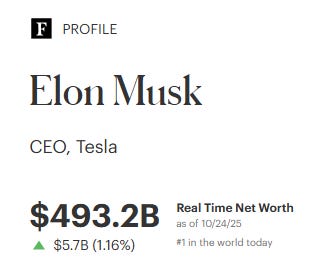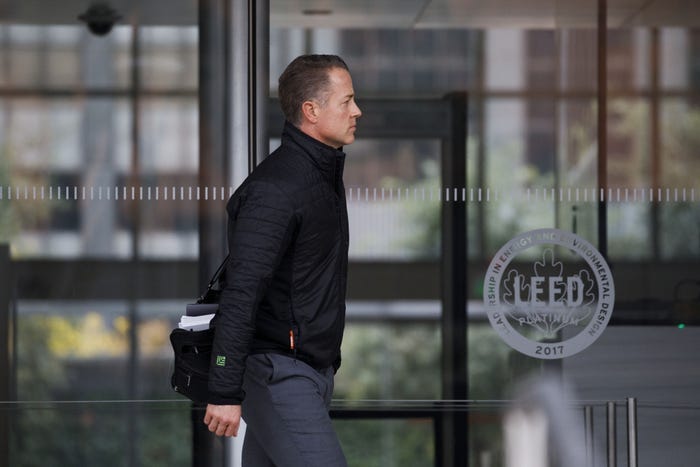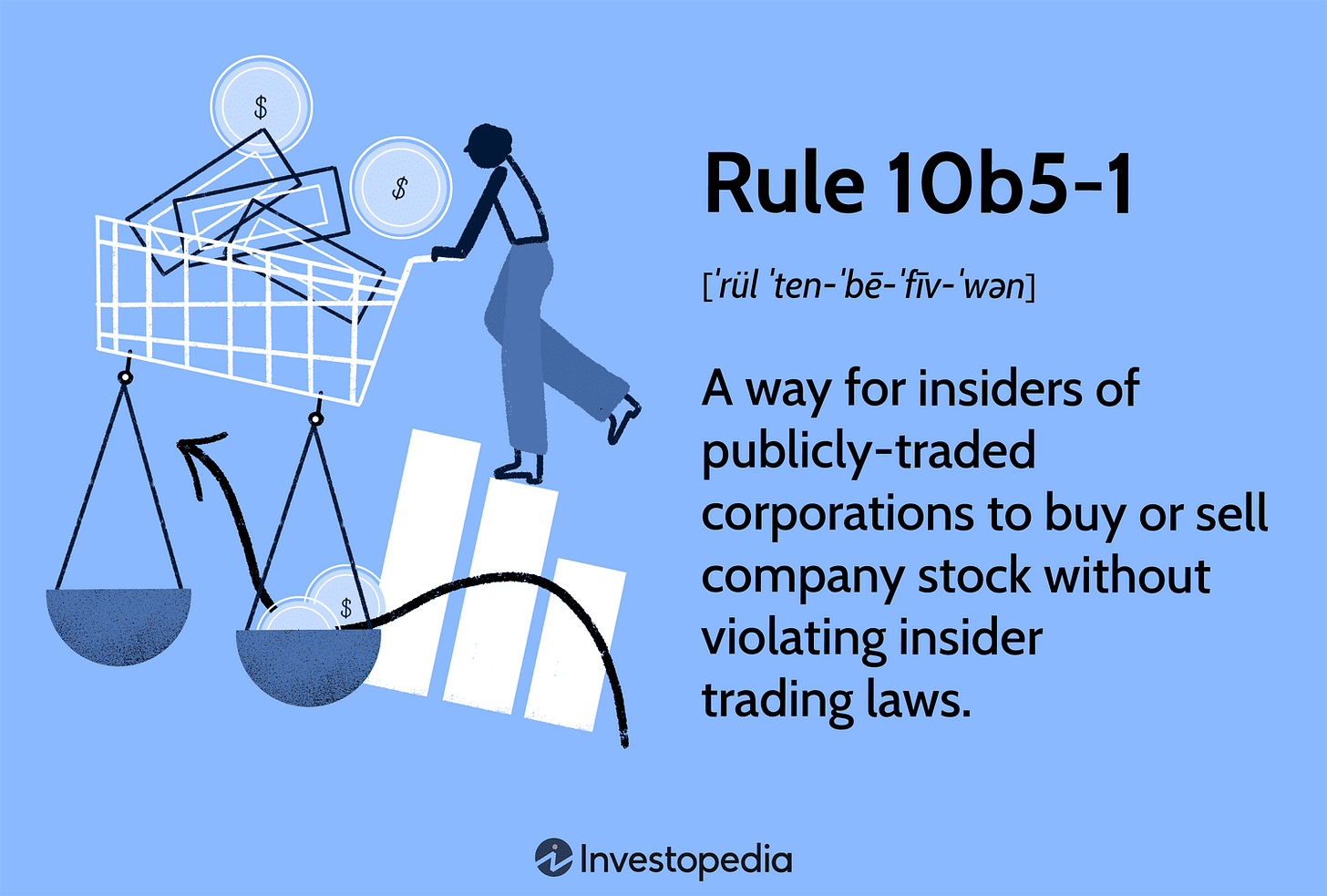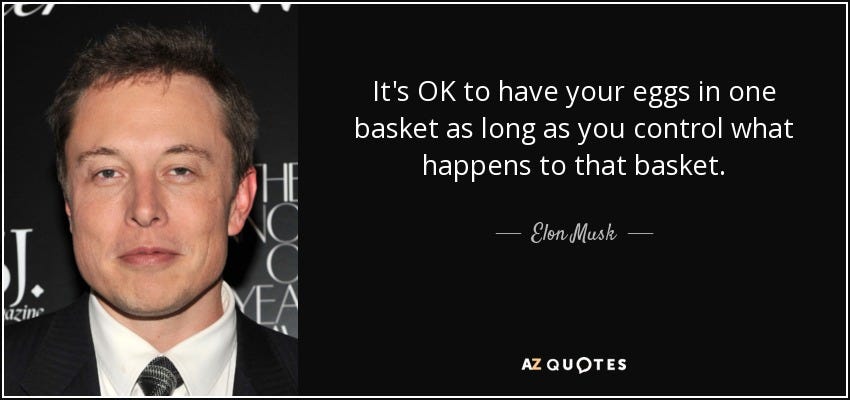How Elon Musk is Trading Crypto & Stocks? (I Found His Strategy Rules)
The world’s richest person controls $500 billion. I wanted to know his exact strategy (in stock & crypto).
Three weeks ago, I was scrolling X (twitter) at 1 AM, and I saw someone ask a question that broke my brain: “Does Elon Musk use moving average crossovers to trade Tesla?”
I laughed. Then I stopped laughing.
Because I realised... I had no idea.
Here’s a guy worth over $500 billion. The richest person on Earth. He tweets and markets move. Dogecoin pumps 40% when he posts a meme. Tesla swings $50 billion in market cap on a single earnings call.
But what’s his strategy?
Does he check charts before buying? Does he have alerts set? Is there some indicator he watches that we don’t know about?
I needed to know. Not because I thought I could copy him, but because... come on. If you could peek inside the trading account of the world’s richest person, wouldn’t you?
So I went digging.
SEC filings. Court documents. Regulatory disclosures. I pulled every Form 4 filing I could find. I traced corporate structures. I followed the money through shell companies and family offices.
What I found was so strange, so counterintuitive, that I had to read some documents three times to believe them.
And by the end, I realised: everything I thought I knew about how rich people invest was wrong.
Let me show you what I mean.
The First Clue: Something Didn’t Add Up
I started where any normal person would start, looking for Elon’s stock purchases.
If he’s worth $500 billion and he’s supposedly this genius investor, there should be a trail, right? Buy orders. Sell orders. Some kind of pattern.
So I opened the SEC’s EDGAR database (it’s free, anyone can access it) and searched for Elon Musk’s insider transaction filings. These are the Form 4 documents that insiders have to file within 2 business days of any stock transaction.
And that’s when I noticed something weird.
In September 2025, Elon made headlines for buying $1 billion worth of Tesla stock. News outlets covered it. X went crazy. Everyone was analyzing what it meant.
But here’s what caught my eye was his first personal purchase of Tesla stock in five years.
Five. Years.
Think about that. The CEO of Tesla. The largest shareholder. The guy whose entire net worth is tied to the company. And he hadn’t personally bought a single share in half a decade.
That’s when I knew something was off.
Why would someone worth $500 billion, who clearly believes in his company, not be buying more stock?
The answer to that question opens up a rabbit hole that goes way deeper than I expected.
The $44 Billion Question Nobody’s Asking
Before I tell you what I found, let me show you something else that didn’t make sense.
In 2022, Elon bought Twitter for $44 billion. (Now called X, but whatever.)
$44 billion.
Where did that money come from?
His net worth at the time was mostly Tesla stock. And I checked the filings: he didn’t sell $44 billion worth of shares. Not even close.
So how do you buy a $44 billion company without selling your main asset?
This question haunted me for days. Because if you or I wanted to buy something worth $44 billion (lol), we’d have to sell our assets, right? Pay capital gains tax. Convert everything to cash. Wire the money.
But that’s not what happened here.
And when I figured out the mechanism he used, I realized: rich people don’t play by the same financial rules we do.
Not because they’re cheating. But because they have access to financial tools most of us have never even heard of.
I’ll come back to this. First, I need to show you who’s pulling the strings behind the scenes.
The Man You’ve Never Heard Of
Pop quiz: Who manages Elon Musk’s money?
Is it:
A) Elon himself, late at night (using Robinhood) after running three companies
B) Some big Wall Street firm like Goldman Sachs
C) A guy named Jared you’ve probably never heard of
If you guessed C, you’re paying attention.
His name is Jared Birchall. Former Morgan Stanley banker. And if you Google him, you won’t find much. No Twitter account with millions of followers. No podcast appearances. No CNBC interviews.
But this guy controls more money than most hedge funds.
In 2016, Elon set up something called Excession LLC. It’s what’s known as a “single-family office.” Think of it like a private company whose only job is to manage one person’s wealth.
Jared runs it.
And here’s where it gets interesting: according to court filings I dug up, Jared Birchall “exclusively manages Elon Musk’s cryptocurrency trades.”
Read that again.
When Elon tweets about Dogecoin and it pumps 40%, who do you think is executing those trades?
Not Elon.
When Elon says he owns Bitcoin, who’s managing that position?
Jared.
So if Elon’s not the one clicking “buy” and “sell,” what is he doing?
This question becomes even stranger when you look at what he’s legally allowed to do.
The Rules That Change Everything
Here’s something I didn’t know before I started researching this:
If you’re the CEO of a public company and you own a massive chunk of its stock, you can’t trade it like a normal person.
You’re what the SEC calls an “insider.” And there are rules. Lots of rules.
I pulled Tesla’s internal insider trading policy (it’s public, buried in their 10-K filing). Here’s what it says:
Insiders are prohibited from trading in options, puts, calls, or any derivatives related to Tesla stock.
They also can’t sell stock short. Can’t bet against the company. Can’t do much of anything spontaneous.
But after Elon’s famous “funding secured” tweet in 2018 (you know, the one where he said he was taking Tesla private at $420), the SEC sued him. He paid a $20 million fine. Had to step down as chairman.
So when people ask “does Elon use moving averages to trade Tesla?”... the answer is more complicated than yes or no.
Because there’s a mechanism that controls when and how he can sell. It’s called a Rule 10b5-1 trading plan.
And understanding this mechanism changes everything.
The Machine That Sells For Him
Imagine you’re the CEO of a company. You know things the public doesn’t know. Earnings numbers before they’re released. Product problems. Major deals in the works.
If you traded based on that information, you’d go to jail. That’s insider trading.
But you still need to sell stock sometimes. Maybe to pay taxes. Maybe to fund other projects. So what do you do?
You set up a 10b5-1 plan.
Here’s how it works: At a time when you DON’T know any secret information, you create a pre-scheduled plan. “Sell X shares on this date” or “sell Y shares if the price hits Z.”
Then it executes automatically. No discretion. No checking charts. No “let me see how the stock’s doing today.”
It’s like setting up autopay for your bills, except instead of paying Netflix, you’re selling $10 billion in stock.
In late 2021, when Elon ran that Twitter poll asking if he should sell 10% of his Tesla stock, I found the actual Form 4 filing from what happened next.
He didn’t just wake up and sell. The sales were executed through a pre-existing 10b5-1 plan. The reason? To pay taxes on stock options he was exercising.
He exercised 1,554,176 stock options. The government wanted their cut. So he sold shares to cover the tax bill.
Not because the chart looked bad. Not because the 200-day moving average broke. Because the IRS wanted $11 billion.
This is not “trading” in any sense that you or I would recognize.
But it gets stranger.
The Portfolio That Breaks Every Rule
You know what they teach you in Finance 101?
“Don’t put all your eggs in one basket.”
“Diversify across sectors.”
“Never have more than 10% of your wealth in a single stock.”
I wanted to see how Elon’s portfolio was diversified. How much Tesla versus how much cash versus how much real estate versus bonds versus other stocks.
So I pulled every disclosure I could find. Searched for his 13F filings (the forms that show stock holdings). Looked for mentions of other investments.
And here’s what I found:
He owns basically nothing except his own companies.
No SPY. No QQQ. No Apple or Microsoft. No bonds. No diversified portfolio of blue-chip dividend stocks.
100% concentrated in:
Tesla (19.7% of the company)
SpaceX (42% of the company, valued around $449 billion)
xAI and X/Twitter (59% ownership, valued around $113 billion)
The Boring Company
Neuralink
Some Bitcoin, Ethereum, and Dogecoin
That’s it. Not the perfect allocation/diversification.
But here’s what’s even crazier, most of this wealth is locked up.
SpaceX? Private company. Can’t just sell your shares on the open market.
xAI? Private.
Neuralink? Private.
Even his Tesla stake. if he tried to sell everything tomorrow, the stock would crater. The market can’t absorb that much supply. He’d destroy his own net worth in the process.
So he’s worth $500 billion on paper. But he can’t access most of it.
Which brings me back to that $44 billion question from earlier.
How do you spend money you can’t access?
The Trick Billionaires Use (That Nobody Talks About)
Remember how I couldn’t figure out where Elon got $44 billion to buy Twitter without selling his Tesla stock?
Here’s the answer: He borrowed it.
Not like you or I would borrow money from a bank for a car loan. This is different.
He went to major banks and said “I’ll pledge my Tesla shares as collateral. Give me billions in loans at 2-3% interest.”
The banks looked at his Tesla stock (worth way more than the loan amount) and said “Deal.”
Now here’s the “genius” part:
The loan money isn’t taxable (it’s debt, not income)
He doesn’t have to sell shares (so no capital gains tax)
He still owns the stock (maintains control and upside)
The interest rate is stupidly low (2-3% when his stock grows way faster)
This is how ultra-wealthy people access cash without triggering massive tax bills.
But there’s a dark side to this strategy.
And when I realized what it was, I understood why Elon’s entire approach to “investing” is nothing like what retail traders do.
The Risk That Could Destroy Everything
Here’s the “bad“ scenario.
You’ve borrowed billions using your stock as collateral. The bank has a rule like the collateral has to be worth at least, say, 150% of the loan amount.
Then the stock market crashes. Your Tesla shares drop 50%.
Suddenly, your collateral isn’t enough. The bank calls you. “Add more collateral or pay back the loan. Now.”
This is called a margin call.
And if you can’t cover it, you’re forced to sell shares at the worst possible time. Which pushes the stock down further. Which triggers more margin calls. Which forces more selling.
It’s a death spiral.
I found news articles from 2022 speculating about whether Elon could face margin calls if Tesla dropped too far. The risk was real.
(He’s since said he doesn’t currently have personal loans against Tesla stock, but the mechanism is what matters here.)
This means Elon’s entire financial structure depends on one thing: Tesla’s stock price staying up.
Not going up based on moving averages crossing. Not breaking out above resistance. Just... staying high enough that the whole leveraged structure doesn’t collapse.
This is why his “strategy” looks nothing like technical analysis or day trading.
His strategy is making sure the companies he owns keep executing. Keep growing. Keep hitting milestones that justify the valuation. (Retailers: “Buy & Hope“)
Because if the stock crashes, everything unravels.
So What’s the Strategy? (The Part You’ve Been Waiting For)
Three weeks of research. Dozens of SEC filings. Court documents. News reports. Corporate disclosures.
And here’s what I can tell you about Elon Musk’s investment strategy:
He doesn’t have one. Not in the way you think.
There’s no moving average system. No RSI divergence playbook. No support and resistance levels marked on a chart.
When I say he “doesn’t trade,” I don’t mean he’s bad at it. I mean he structurally cannot trade the way retail investors do.
Here’s what his approach looks like:
Step 1: Build a company from scratch
He doesn’t buy stocks. He creates them. SpaceX didn’t exist until he started it with $100 million from the PayPal sale. Tesla was weeks from bankruptcy when he took over and poured in his own money.
Step 2: Go all-in on companies he controls
100% concentration. No diversification. His famous quote: “It’s OK to have your eggs in one basket as long as you control what happens to that basket.”
You can’t do this with Apple stock. You don’t control Apple. But Elon’s the CEO of his companies. He decides strategy. He hires and fires. He controls the outcome (or tries to).
Step 3: Hold forever
There’s no exit plan. No “I’ll sell when it hits my target.” The goal is to hold until Mars is colonized, AI is solved, or sustainable energy dominates the planet.
Time horizon: decades.
Step 4: Borrow against the shares when cash is needed
Never sell. Take loans using the stock as collateral. Access liquidity without triggering taxes or losing control.
Step 5: Let professionals handle the details
Excession LLC (run by Jared Birchall) executes everything. Compliance. Tax optimization. Collateral management. Crypto trades. The operational machinery.
That’s it.
No indicators, no backtests, no “when the 50 crosses the 200, I enter.”
His strategy is: build world-changing companies, maintain control, hold forever, borrow when you need cash, and delegate the administrative stuff to pros.
But What About the Crypto?
Okay, so he can’t trade Tesla freely. But what about his Bitcoin and Dogecoin?
Hmm, now it get interesting again.
Elon has publicly confirmed he owns Bitcoin, Ethereum, and Dogecoin. He’s posted memes about DOGE. He’s integrated it into Tesla’s merchandise payments. He even joined the Dogecoin Foundation as an advisor.
And when he tweets about DOGE, it pumps. Every. Single. Time.
So is this where the strategy lives? Is he trading these? Timing the pumps?
I went looking for evidence.
And here’s what I found in those court filings: Jared Birchall exclusively manages his crypto trades.
Not Elon.
So when DOGE pumps 40% on a tweet, Elon’s not frantically opening Coinbase to sell at the top. Birchall’s team at Excession handles execution.
Elon provides strategic direction (”I believe in DOGE”). Excession executes.
But here’s what I couldn’t find anywhere:
Any evidence of a systematic strategy. No “I buy when RSI is oversold.” No “I use Bollinger Bands.” Nothing.
It’s more like: “I believe this asset has long-term value, I’ll hold it, and my team will handle the details.”
Again: conviction-based, long-term holding. Not trading.
The Philosophy Behind Everything
After all this research, I started asking a different question.
Not “what’s his strategy?” but “what’s his philosophy?”
Because there had to be some underlying logic. Some framework he uses to decide what to invest in.
And I found it in interviews and public statements.
He calls it “first principles thinking.”
Here’s how it works: Instead of copying what everyone else does or following conventional wisdom, you break down a problem to its fundamental truths. Then you build up from there.
For investing, this means:
“What companies need to exist for humanity to have a good future?”
His answer:
Sustainable energy (Tesla/Solar)
Space exploration and backup civilization (SpaceX)
AI safety and advancement (xAI)
Brain-computer interfaces (Neuralink)
Better infrastructure (Boring Company)
He doesn’t invest in these because they’re undervalued or oversold on the RSI. He invests because they need to exist.
And since no one else was building them the way he wanted, he built them himself.
This is what people mean when they say he’s not an “investor” in the traditional sense. He’s a founder who happens to have a massive portfolio because he founded the companies.
The wealth is a side effect of the mission, not the goal.
At least, that’s the narrative. Whether you believe it or not is up to you.
The Three Things I’m Taking Away
After all this, here’s what I’m keeping:
1. Time horizon matters more than timing
If your strategy requires watching charts daily, you’re playing a different game than the ultra-wealthy. Neither is wrong. But pick one and optimize for it.
Elon’s time horizon is decades. That’s why technical indicators don’t matter to him. If yours is weeks or months, they might matter to you.
Match your tools to your timeframe.
2. Infrastructure compounds returns
Musk doesn’t manage his own compliance, taxes, or execution. He has Excession for that. As your account grows, systems and professional help multiply your edge.
Don’t try to do everything yourself forever.
3. Concentration requires control
Elon can go all-in on Tesla because he’s the CEO. He controls the outcome (or tries to). You can’t do that with SPY or Apple.
If you’re concentrating positions, you better have an edge and a plan. Otherwise, diversification isn’t just safe, it’s smart.
What I’m Doing Next
This research opened up more questions than it answered.
I want to know: how do OTHER ultra-wealthy people structure their (personal) portfolios (“trading strategies”)?
How do sovereign wealth funds make allocation decisions? Who’s behind the scenes?
I’m planning to research more of these institutional structures. Not to copy them (you can’t), but to understand how serious money moves.
Because I think we’re asking the wrong questions as retail traders.
We obsess over indicators and timeframes and entry signals. Meanwhile, institutional players are optimizing structure, delegation, and process.
Maybe the edge isn’t in the chart. Maybe it’s in the system.
How I Did This Research
Everything here came from public sources:
SEC EDGAR database (Form 4 filings for insider transactions)
Tesla’s 10-K annual reports and proxy statements
Court filings (including the 2018 SEC lawsuit)
Corporate records for Excession LLC
News reports from Bloomberg, Reuters, WSJ (verified against filings)
No speculation. No Twitter threads. No “sources say.” Just documents.
If you want to verify anything, the SEC’s EDGAR system is free. Search Tesla’s CIK (0001318605) and filter for Elon Musk’s Form 4 filings.
The information is there. You can see it yourself.
This turned into a super long article.
I’ll leave it as is for now, but if you need shorter ones in the future, let me know.
Also, tell me which ultra high-net-worth personal trading/investing strategy I should check out next.
Disclaimer: The information provided is NOT financial advice. I am not a financial adviser, accountant or the like. The information I found comes from verified news publishers and sources, but it could still be wrong.



























This is some seriously deep digging, respect. The part about Jared Birchall managing the crypto trades really changes how you think about those DOGE tweets. It's not Elon frantically buying or selling, it's a whol structured operation behind the scenes. Makes you wonder if the conviction based holding apporach actually works better than all the technical analysis we obsess over. Though I gotta say, the leverage risk you mentioned is pretty terrfying when you think about what could happen if Tesla tanked.
Bravo!